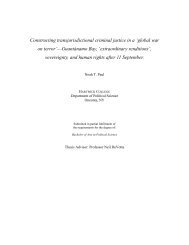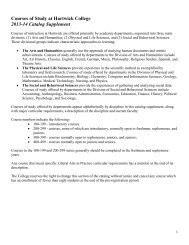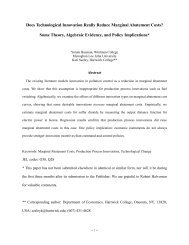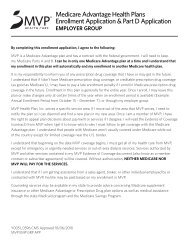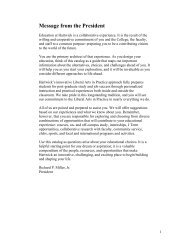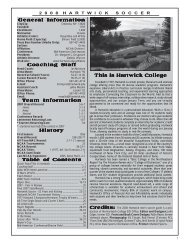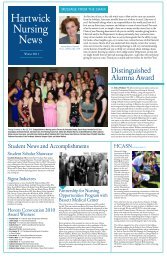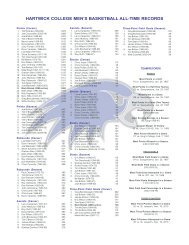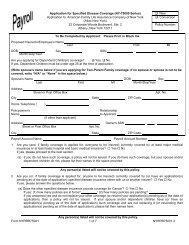Table of Contents - Hartwick College
Table of Contents - Hartwick College
Table of Contents - Hartwick College
Create successful ePaper yourself
Turn your PDF publications into a flip-book with our unique Google optimized e-Paper software.
or “adaptive zone”), (2) developmental patterns and life history strategies<br />
and (3) evolution and phylogenetic relationships. These three themes are<br />
used as a common thread to tie the animal phyla together in a logical and<br />
interesting way. The laboratory portion includes field trips to fresh-water<br />
ecosystems. Prerequisites: Biol 104, 105. (LAB)<br />
210 Microbiology <strong>of</strong> Disease (4 credits; 3 one-hour lectures, 1 three-hour<br />
laboratory weekly) This course will introduce the field <strong>of</strong> microbiology and its<br />
role in human disease. Mechanisms by which microorganisms cause disease and<br />
how humans prevent and treat such diseases will be discussed. The course will<br />
focus on six core objectives: 1) classification <strong>of</strong> microorganisms into different<br />
groups, 2) growth and reproduction, 3) processes <strong>of</strong> infection, 4) host defenses,<br />
5) identification <strong>of</strong> disease-causing microorganisms, and 6) control <strong>of</strong> microbial<br />
growth. Prerequisites: CHEM 105 or permission <strong>of</strong> the instructor. (LAB)<br />
215 Microbiology (4 credits; 3 one-hour lectures, 1 three-hour<br />
laboratory weekly) The impact <strong>of</strong> microorganisms on our lives is broad<br />
and involves many fields, for example environmental sciences, industry,<br />
ecology, agriculture and human health. This course will introduce basic<br />
concepts <strong>of</strong> microbiology and explore how microorganisms impact our<br />
planet, inform us about basic scientific principles and cause<br />
disease. Prerequisites: BIOL 104, 105, and 200. (LAB)<br />
221 Vertebrate Zoology (A) (4 credits; 3 one-hour lectures, 1 threehour<br />
laboratory weekly) Study <strong>of</strong> evolution <strong>of</strong> adaptive diversity in form<br />
and function among living and extinct species <strong>of</strong> fishes, amphibians,<br />
reptiles (including dinosaurs), birds and mammals. Includes a survey <strong>of</strong><br />
the local vertebrate fauna and associated ecosystems. The laboratory<br />
portion includes comparative anatomy, morphometric and functional<br />
analyses <strong>of</strong> vertebrate body designs, as well as field expeditions to Pine<br />
Lake and other nearby areas, and visits to museum collections.<br />
Prerequisites: Biol 104, 105, 200 or permission <strong>of</strong> instructor. (LAB)<br />
223 Horticulture (4 credits; 3 one-hour lectures and 1 three-hour<br />
laboratory weekly) A study <strong>of</strong> cultivated plants including studies on plant<br />
growth and development and techniques <strong>of</strong> horticulture. Laboratories will<br />
include the greenhouse in learning various techniques <strong>of</strong> horticulture.<br />
(LAB)<br />
225 Aquatic Ecology (4 credits; 3 one-hour lectures, 1 three-hour<br />
laboratory weekly) Study <strong>of</strong> the ecology <strong>of</strong> communities and ecosystems<br />
using examples drawn from the study <strong>of</strong> aquatic (freshwater and marine)<br />
habitats. Topics include community structure and diversity, species<br />
interactions, ecosystem function, and human impacts on communities<br />
and ecosystems. Laboratories are conducted mainly at the Pine Lake<br />
campus and surrounding aquatic communities. Prerequisites: Biol104,<br />
105; for biology majors or permission <strong>of</strong> instructor. (LAB)<br />
235 Ecology and the Environment (4 credits; 2 one-and-one-halfhour<br />
lectures and 1 three-hour laboratory weekly) Study <strong>of</strong> the basic<br />
principles <strong>of</strong> ecology including energy flow, nutrient cycling, population<br />
dynamics, and succession. Four major topics <strong>of</strong> concentration are<br />
ecosystems, communities, populations, and comparative ecosystems.<br />
Environmental issues are also presented within the course context. The<br />
laboratory component is either a field or laboratory investigation. Nearly<br />
all aspects <strong>of</strong> the course are taught at Pine Lake. This course satisfies one<br />
62



